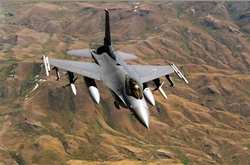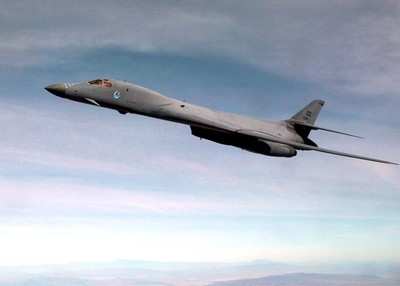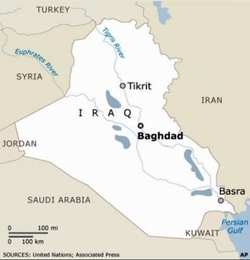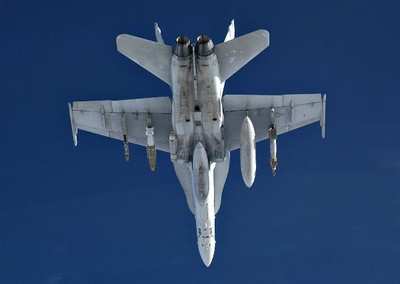Campaign Launched January 10
 Thousands of pounds of
bombs rained down near the village of Arab Jabour on January 20, as
coalition forces continued their relentless pursuit of al-Qaeda. A
military commander in the region said the drop was designed to
eliminate al-Qaeda's tactical advantage before coalition ground
forces move in to clear the heavily agricultural community
southeast of Baghdad.
Thousands of pounds of
bombs rained down near the village of Arab Jabour on January 20, as
coalition forces continued their relentless pursuit of al-Qaeda. A
military commander in the region said the drop was designed to
eliminate al-Qaeda's tactical advantage before coalition ground
forces move in to clear the heavily agricultural community
southeast of Baghdad.
Army Col. Terry Ferrell, commander of 3rd Infantry Division's
2nd Brigade Combat Team, with responsibility for the Arab Jabour
portion of Multinational Division Center, said in an interview that
the improvised explosive devices targeted by the bombing were part
of a "defensive belt" al-Qaeda had established around Arab Jabour
to keep coalition forces from entering the area.
"The strikes that we concluded (Jan. 20) were focused on IEDs
and caches that we have targeted, that will allow us to get our
ground troops further into the zone," Ferrell said.
The roadside bombs and other explosives "pose great risk to our
soldiers, catastrophic risk to our soldiers, and we've used the Air
Force to help reduce those risks," Ferrell said.
Some 19,000 pounds of bombs hit 35 targets in an initial series
of precision air strikes that lasted more than two hours. A
combination of Air Force, Navy and Marine aircraft was used in the
strikes, including F-18 Hornet fighter jets and B-1 Lancer bombers.
By the time follow-on strikes were completed, 34,500 pounds had
been dropped on 40 targets.
In total, coalition forces dropped 114,500 pounds of bombs
around Arab Jabour over a 10-day period that also included strikes
on January 10, as ANN reported, and January
16. In all, 104 targets were struck.

"The operation that occurred on January 10 was part of the
shaping of the operation for (January 20)," Ferrell said. "All
along, we have been conducting operations underneath of the
airstrikes that allow our soldiers to enter into the areas that
we've not been before."
Despite the scale of the bombing, Ferrell said, great care was
taken in selecting targets, as the Army worked side by side with
the Air Force to prevent collateral damage to civilians and
property.
 "The process that we go
through to orchestrate an event of this magnitude, or any targeting
cycle that we work together with the Air Force, is a very detailed,
deliberate process," Ferrell said. "We identify the targets, and
they sit beside us, and through detailed and thorough analysis, we
target it, they help analyze it, describe what effects we want to
achieve, and then they work back through the Air Force system to
get the desired effects."
"The process that we go
through to orchestrate an event of this magnitude, or any targeting
cycle that we work together with the Air Force, is a very detailed,
deliberate process," Ferrell said. "We identify the targets, and
they sit beside us, and through detailed and thorough analysis, we
target it, they help analyze it, describe what effects we want to
achieve, and then they work back through the Air Force system to
get the desired effects."
This most recent operation was conducted to improve quality of
life and restore stability to southern Arab Jabour, similar to what
has been accomplished further north in the region, the colonel
said.
"We can get in and establish the operations to allow these
people to have the same success and the same privileges that we've
been able to establish in the northern portions of our area -- in
the cities of al Buyatha, Hawr Rajab, Adwaniyah, where the people
can now walk freely on their streets, the kids can go to school,
(and) the markets can come alive," Ferrell said.
Areas like Hawr Rajab have improved dramatically relative to
Arab Jabour, thanks in part to coalition-led capacity-building
programs. Under the military's local-engagement model, these
programs are coordinated with tribal leaders and their kin, some of
whom were former members of the insurgency. Community development
initiatives and jobs programs work by giving Iraqis a stake in
their communities' welfare, US commanders say.
"As time goes by, it will be less likely for them to turn
against us. At the end, they want to secure their communities and
feed their families," Army Lt. Col. Mark Solomon, commander of the
3rd Infantry Division's 6th Squadron, 8th Cavalry Regiment, 2nd
Brigade Combat Team, told The Associated Press.
The challenge now for military commanders in the region is to
link together areas they have improved into a system that can
withstand insurgent violence.
"It's a march of clearing towns, making sure it's secure,
establishing local citizens groups, bringing in the Iraqi army,
jump-starting the economy with micro-grants and trying to get local
government up and running, Solomon explained in a separate
interview with USA Today. "Only then do the soldiers look forward
to the next town on the map."
Despite a concerted shift to capacity-building by US troops, "a
relentless pursuit of the enemy" will continue, Ferrell said.

"Wherever al-Qaeda wants to operate, we're going to find him,"
Ferrell said. "We're going to capture him; we're going to kill him,
because we're not going to allow him to believe that he has any
ground that he can hold to call his own or where he can find
sanctuary."
(Aero-News thanks Tim Kilbride, Task Force Marne Public
Affairs, Special to American Forces Press Service.)
 ANN's Daily Aero-Term (05.24.25): Search And Rescue
ANN's Daily Aero-Term (05.24.25): Search And Rescue ANN's Daily Aero-Linx (05.24.25)
ANN's Daily Aero-Linx (05.24.25) Classic Aero-TV: Goodyear's Wingfoot One - What it Takes to Tour in a Zeppelin
Classic Aero-TV: Goodyear's Wingfoot One - What it Takes to Tour in a Zeppelin Airborne-NextGen 05.20.25: Drone Regs, Zero-Emission Cargo, Door-Dash Drone
Airborne-NextGen 05.20.25: Drone Regs, Zero-Emission Cargo, Door-Dash Drone Classic Aero-TV: Efficient Versatility -- NASA GL-10 Greased Lightning
Classic Aero-TV: Efficient Versatility -- NASA GL-10 Greased Lightning






